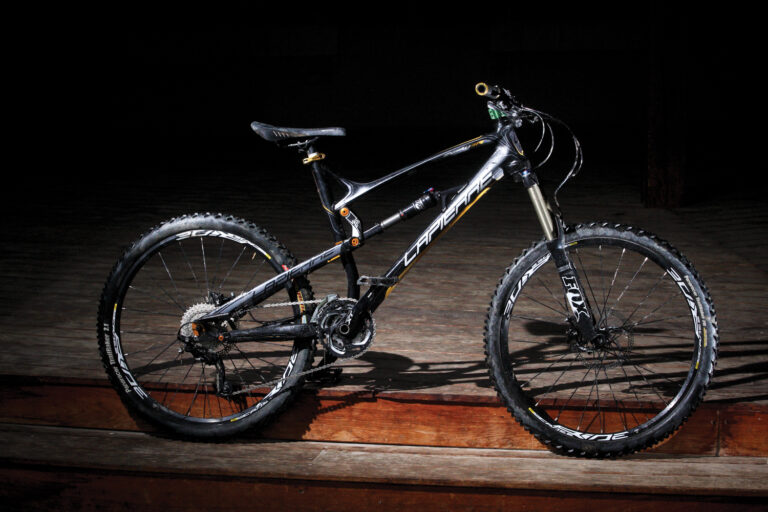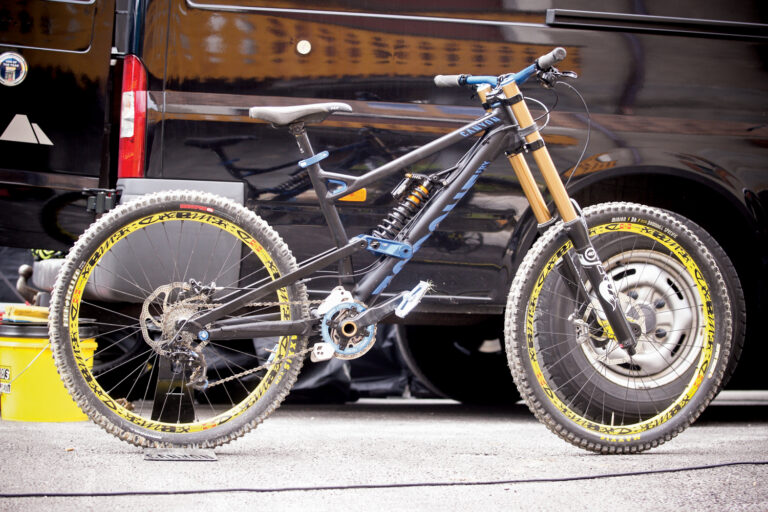 DEVELOPMENT OF THE BIKE
DEVELOPMENT OF THE BIKE
For some time now, Nico Menard (the bike designer/engineer at Commencal) has been carefully taking notes from a cross–section of mountain bikers (that being the staff at Commencal), examining these findings against those of the factory team (coincidentally some of the most successful and well–rounded riders of the moment) and quietly combining both into what should, in theory, be the fastest, most capable, bike of its type.
According to Nico, “the way people ride is changing”, something I certainly can’t disagree with and I applaud his theory – mountain bikers are crying out for a true all–round bike, something that climbs, that descends and that doesn’t break on a regular basis. But then that’s what every manufacturer is attempting, isn’t it? Has Nico succeeded? I think he very nearly has. Read on…
KEY PLAYERSThe Atherton family and Commencal’s factory team provided data and valuable notes on their 2010 Downhill World Cup winning machine, the Supreme DH, which helped Nico to progress the Supreme into the most recent version – the Supreme V3. The new bike is visually very different to the 2010 ride and the previous bike’s weaknesses have been considered and accounted for with new features and a fresh suspension platform. This new  linkage of course must come with a name (a marketing tag) which in this case is called the ‘Contact System Evo’ (although it’s refreshing not to see this plastered all over the bikes). The linkage clearly performs as it has propelled Gee and Rachel Atherton to multiple podiums already this year, and Nico has transferred the same system onto the new All Mountain – all sounds good so far.
linkage of course must come with a name (a marketing tag) which in this case is called the ‘Contact System Evo’ (although it’s refreshing not to see this plastered all over the bikes). The linkage clearly performs as it has propelled Gee and Rachel Atherton to multiple podiums already this year, and Nico has transferred the same system onto the new All Mountain – all sounds good so far.
Remy Absalon is Commencal’s French enduro star, winner of numerous titles including the most prestigious of them all, the Megavalanche in Alpe d’Huez. Remy and his mechanic, Jean–Yves, have been key in the development and theory behind this new All Mountain machine and have been able to carry and prototype the Meta through it’s transitional phase to the point where it now incorporates an almost identical feature–list to the DH bike; internal cable routing, alignment tabs in the headtube (for angle reducer cups), low centre of gravity, low stand-over height (due to two–piece top tube) and so on.
FRAME CONSTRUCTIONThis is a bike to be ridden fast, just like the Supreme V3, but as it is aimed at an all–mountain market the similarities must end somewhere. Aside from the obvious (i.e. 150 mm travel and air shock), Nico has thought long and hard about the intended purpose and has structured the All Mountain to cater for its correct market. Strength, efficiency and attention to detail are key in the role of a bike that ‘does it all’ – although clearly compromise cannot be entirely avoided – and thankfully Nico and his crew at Commencal HQ have seemingly put a lot of thought into the requirements of an all–mountain bike.
7005 triple butted alloy tubing, 67º standard head angle, ISCG 05 chain guide tabs (“for guys who wanna huck” – Nico) and rear post mount for 180mm discs provide a firm base for fast downhills and clearly state the intentions of the designer. Yet a relatively steep seat–tube (that allows up to a 300mm seatpost), the shock is off–set by 6mm to the left (to optimize the bike for a 2×10 chainset) and the main pivot being positioned close to the chainline (to increase pedalling efficiency) all equate to a rounded and evidently well–thought out frame that Nico should be very proud of. This is a bike that appears to minimise compromise.
 Durability has previously been an issue with some Commencal frames – something that cannot be denied, and thankfully isn’t by the crew – and now with the new Meta it is great to see that past experiences have been taken into account and problems duly addressed. The ‘Contact System EVO’ makes use of a split axle main pivot to allow space for the bike’s distinctive ‘shock tunnel’, which, in creating a ‘floating shock’ (in essence the shock isn’t actually attached to the main frame at all), allows less direct stress on the frame and handily lowers the centre of gravity at the same time. Forces are further directed away from the pivots through use of the two–part top tube that is welded “as close as possible” to the shock tunnel. The pivots are assembled of 10 and 15mm axles throughout, and all run on over–sized bearings for “optimal reliability and rigidity”.
Durability has previously been an issue with some Commencal frames – something that cannot be denied, and thankfully isn’t by the crew – and now with the new Meta it is great to see that past experiences have been taken into account and problems duly addressed. The ‘Contact System EVO’ makes use of a split axle main pivot to allow space for the bike’s distinctive ‘shock tunnel’, which, in creating a ‘floating shock’ (in essence the shock isn’t actually attached to the main frame at all), allows less direct stress on the frame and handily lowers the centre of gravity at the same time. Forces are further directed away from the pivots through use of the two–part top tube that is welded “as close as possible” to the shock tunnel. The pivots are assembled of 10 and 15mm axles throughout, and all run on over–sized bearings for “optimal reliability and rigidity”.



